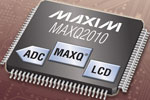

Maxim recently introduced the MAXQ2010, a 16-bit mixed-signal microcontroller with a unique power-saving stop mode.
Stop mode reduces power consumption to 370 nA typical and 6,5 μA maximum at +85°C, thus extending the life of battery-powered devices.
Designed on a RISC architecture, the MAXQ2010 balances high-speed execution (up to 10 MIPS at 10 MHz) and data sampling with a low-power active-mode current (3,1 mA at 10 MHz). An integrated regulator allows direct operation from a single lithium coin cell at 2,7 V to 3,6 V.
With its many integrated analog and digital capabilities and its multiple power-saving modes, the MCU is a single-chip solution optimised for battery-powered data acquisition applications. The device’s low-power stop mode makes it especially valuable in equipment that spends the majority of its life inactive, only waking up once every few minutes to take measurements. Typical examples include many types of sensors, data acquisition systems and environmental data-loggers.
The MAXQ2010 offers multiple power-saving operating modes. A key feature of the device is its stop mode, which allows the microcontroller to reduce power consumption to less than 400 nA by halting code execution. Depending on the needs of the application, the integrated LCD controller and realtime clock can optionally remain active during stop mode.
The device includes a 12-bit ADC capable of data conversion at up to 312 KSps. Samples are taken from up to eight analog inputs which can be selected as single-ended inputs and/or differential input pairs. The ADC includes a 1,5 V ±2% voltage reference and can be configured to automatically capture and buffer sequences of up to 16 samples without processor intervention.
The MAXQ2010 provides additional features critical for portable, battery-powered applications. For a user interface, an integrated LCD controller can drive up to 160 segments directly in a ¼-muxed configuration. A supply-voltage monitor measures the power supply against a programmable threshold from 2,7 V to 3,5 V in 0,1 V increments, enabling an application to detect low power and notify the user to replace the battery.
To further reduce system costs, the MCU uses a low-cost 32 kHz crystal to generate the 8,389 MHz system clock and enable the realtime clock (RTC) peripheral. The RTC provides programmable sub-second and time-of-day alarms, which can be used to wake up the microcontroller from stop mode to perform functions at programmable time intervals.
For rapid application development, a MAXQ2010 evaluation kit is available. Providing both the microcontroller evaluation platform and all necessary software, the kit connects the MCU’s onboard bootloader and debugging features with PC-side software to communicate with an integrated development environment.
For more information contact Larry Gordon, CST Electronics, +27 (0)11 608 0070, [email protected], www.cstelectronics.co.za
| Tel: | +27 11 608 0070 |
| Email: | [email protected] |
| www: | www.cstelectronics.co.za |
| Articles: | More information and articles about CST Electronics |

© Technews Publishing (Pty) Ltd | All Rights Reserved